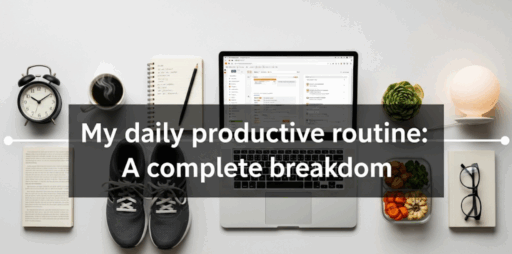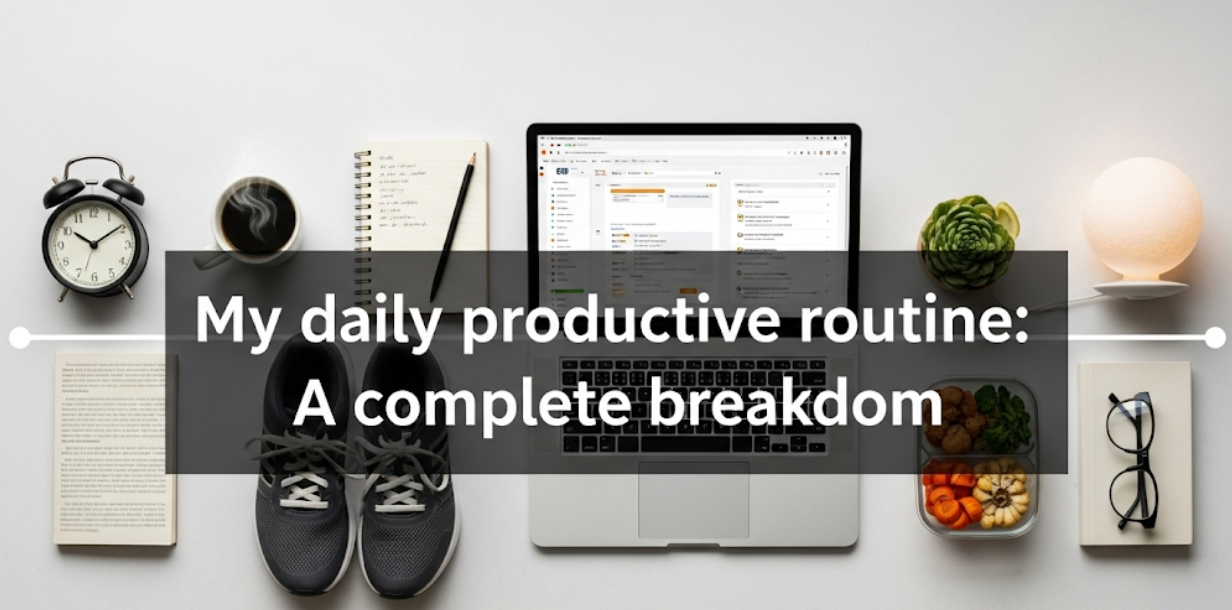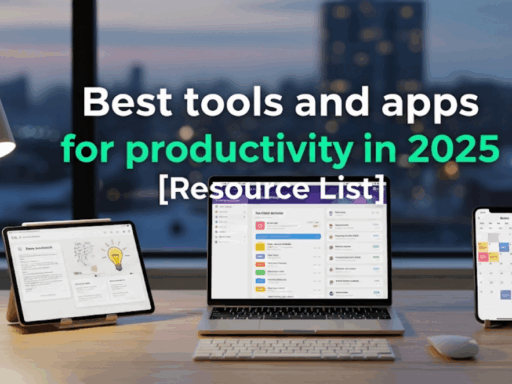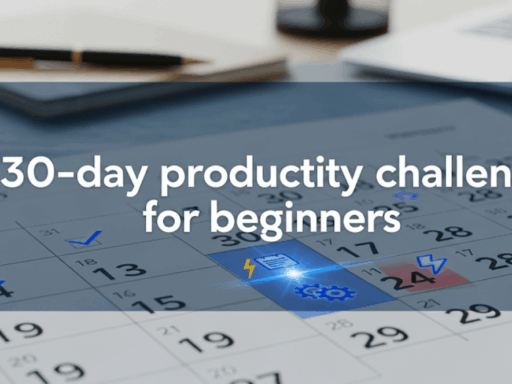A Detailed Account of My Everyday Productive Day
Wondering how some people seem to get so much done in a day, while some of us struggle to do the very basic things? The answer is not superhuman powers or never ending energy, but an optimal daily schedule that reduces waste and increases productivity.
Through years of experimenting, I stumbled upon a daily routine which has significantly increased my productivity and overall quality of life. It is not another overhyped, generic guide with little real-world help. In contrast — I am sharing precisely what I do daily, with dedicated time blocks, tools and techniques that have not just worked in theory, but very well in practice.
If you are a student with multiple subjects to juggle, a professional handling complex projects, or just an individual looking for improving your 24 hours, this breakdown will let you learn actionable habits based on your context. This is the complete framework I have implemented for a stress-free and overwhelming life to do more.
The Secret Behind Daily Routines That Improve Productivity
Before we get to the specifics, we must understand the power behind structured routines. Having a lot of daily habits can preserve you from decision fatigue — the mental tiredness after making too many little decisions in a day.
Here’s the thing: when you already know what is next in your schedule, your brain can direct its focus into the actual work that needs to be done, instead of on making decisions. That’s why so many successful people wear the same outfit every day, and live on a diet of porridge for breakfast — they’re trying to save those precious mental watts for what really matters.
Studies have shown that people who stick to routines are 40% more likely to be able to set and accomplish long-term goals compared with those who live without daily routines. It boils down to implementing systems that align with your natural energy patterns rather than fighting against them.
Daily Morning Launch Sequence
5:30 AM – The Quiet Hour Begins
The truth is, I am NOT a morning person, but at the same time, if I can get control of the first couple hours, then more than likely I will have some type of power to navigate throughout the day. I schedule an hour each morning to get a head-start on the day; it is pure uninterrupted focus time for the activities that are going to come first in terms of my priorities before the world bombards me with its deluge.
The first 30 minutes are about what I call “mental preparation.” This includes:
- Light stretching or Yoga for 10 mins
- Meditation (10 minute session with easy breathing technique)
- 5 min setting my daily priorities (5 at night, reviewing the items, and 6 in the morning)
This is not about you becoming a blissed out meditator or health nut overnight. They act as those rubber bands to help me bounce out of dreamland and into the schedule with minimal resistance.
6:00 AM – Fuel and Focus
Breakfast is always at 6:00 AM and the only thing eaten for breakfast on weekdays is oatmeal with berries, nuts, and a cup of green tea. This consistency cuts decision-making out of the equation and keeps your energy levels stable in the morning.
As I eat my first meal, it usually takes me 15 minutes to look over my calendar and tasks which allows me to switch some things around based on high priorities or anything that changed from the day prior. This preview helps me mentally get ready for the things that need to happen throughout the day.
6:30 AM – The Power Hour
In my own schedule, I work from 6:30 to 7:30 AM which is the time I dedicate to deep work on the most important activity of the day. It could be writing, strategizing, building mastery in something new, or even solving very complex problems.
Why this works so well:
- Mental Clarity: Your brain is focused with no daily distractions
- Guaranteed Progress: Even if the rest of your day gets away from you, you can hang onto this no matter what
- Momentum Boost: Starting the day well builds momentum for the rest of the day
Core Work Block: Peak Output Hours
8:00–12:00 PM — Deep Work Marathon
Following morning preparation, I work during my peak output hours. These are your sacred four hours — no meetings, no email, few distractions. This is how I break down this vital block:
8:00-9:30 AM: Primary Project Focus
- Execute the day’s most difficult or inspirational work
- Control your time: practice the Pomodoro technique (25 minutes of work/5 minutes of break)
- Have a notepad on standby for those random thoughts without breaking focus
9:30-9:45 AM: Movement Break
- Simply walk around the office or your building
- Do basic stretches
- Drink water and have some healthy food
9:45-11:15 AM: Secondary Task Execution
- Operations work (important, but less creative work)
- Process emails requiring thoughtful responses
- Do the phone or video calls that need to be made
11:15-11:30 AM: Energy Reset
- Brief meditation or breathing exercise
- Reflect and adapt how the rest of your afternoon looks like if necessary
- Final grooming session for morning prep
11:30 AM-12:00 PM: Administrative Tasks
- File management and organization
- Quick email responses
- Day scheduling on calendar
| Time Block | Main Task | Energy Level | Focus Type |
|---|---|---|---|
| 8:00-9:30 AM | Creative/Complex | Highest | Deep |
| 9:45-11:15 AM | Important | High | Sustained |
| 11:30 AM-12:00 PM | Admin | Moderate | Detail |
The Science Behind Morning Productivity
Studies have consistently shown that the majority of individuals hit their cognitive stride in the middle of those morning hours. This is due to relatively high levels of cortisol that increase your alertness without the jittery feeling you get from 3 cups of morning coffee. On a mental perspective, your mind is still sharp due to having all that rest earlier in the day, and on an emotional level your blood sugar is much more stable post breakfast and you have fewer distractions in your way.
You’re progressing through the most important work during those golden hours of freedom, and working with your biology, instead of against it. No matter if afternoon energy levels drop or distractions happen, you have already completed a ton of what is most crucial.
Midday Reset: Maintaining Momentum
12:00-1:00 PM: Intentional Break Time
So often people work at lunch or grab food and continue to work. However, this approach obviously isn’t sustainable as it would ultimately lead to burn out and reduced performance in the afternoon. I have to do lunch, but what I get to do is reclaim my power in the form of time and autonomy.
The Midday Reset Formula:
- Exercise (15 minutes): Outside walk if possible, in natural light
- Mindful Eating (30 minutes): Focus on the meal without getting distracted
- Quick Mental Break (15 min): Read something non work-related, listen to music, chat with someone
This hour is not wasted time — it’s an investment in high afternoon output. It refreshes the energy level for the other half: the movement, nutrition and mental rest.
Nutrition Strategy for Sustained Energy
The food you eat at lunch impacts how well you can concentrate and focus in the afternoon. What DOES work for steady energy levels:
Optimal Lunch Components:
- Lean protein (prevents energy crashes)
- Complex carbohydrates (sustained fuel)
- Healthy fats (brain function support)
- Minimal sugar (avoids afternoon crash)
Foods to Avoid:
- Heavy meals that make you tired
- Foods high in sugar that leave you with peaks and valleys of energy
- Too much caffeine that makes you unfocused in the afternoon
Executing in the Afternoon: Riding the Second Wave
1:00-5:00 PM: Strategic Task Management
Afternoons tend to have a different quality of energy and more disruptions. Instead of resisting this natural rhythm, I have crafted my afternoon routine to align with a life lived in cycles.
1:00-2:30 PM: Collaborative Work
- Team meetings and brainstorming sessions
- Client calls and relationship building
- Project coordination and communication
2:30-2:45 PM: Energy Boost
- Light snack (fruit, nuts)
- Brief walk or stretching
- Mindfulness check-in
2:45-4:00 PM: Processing and Organization
- Email management using the two-minute rule
- File organization and document updates
- Research and information gathering
4:00-4:15 PM: Afternoon Reset
- Desk organization and cleanup
- Review accomplishments and remaining tasks
- Adjust priorities if necessary
4:15-5:00 PM: Preparation and Planning
- Next-day preparation
- Weekly goal review and adjustment
- Knowledge building (reading up on industry, learning new skills)
Managing Afternoon Energy Dips
Most people have a natural dip of energy around 2:00–3:00 PM. So rather than chaining yourself to caffeine or slogging through because your brain is foggy, I use my circadian rhythm as a guide:
Strategies for Afternoon Success:
- Schedule routine tasks during low-energy periods
- Use energy peaks for creative or complicated work that requires brain power
- Naturally increase alertness with movement and light exposure
- Embrace the fact that you will operate differently in the afternoon from morning
Evening Wind-Down: Repair & Readiness for Tomorrow’s Success
5:00 – 7:00 PM: Transition Time, Time for Yourself
Your ‘after work’ routine is key to your present well-being, and the next day. There are few reasons why this two-hour time window acts like a magic bullet.
5:00-5:30 PM: Work Closure Ritual
- Complete a final task review
- Organize workspace for tomorrow
- Prepare a list of unfinished thoughts or worries
- Officially “close” the workday mentally
5:30-6:30 PM: Physical Activity
- Workout plan (cardio + strength training)
- Outdoor activities when weather permits
- Sports or recreational physical activities
6:30-7:00 PM: Personal Connection
- Family time or social interaction
- Chatting with friends or family via phone call
- Community involvement or hobbies
The Importance of Physical Activity
Moving regularly is not just about health — it’s a life maintenance tool. This is how afternoon exercising improves workout effectiveness:
- Stress Relief: Exercise helps break down cortisol that accumulates during the day
- Mental Clarity: Exercising in the evening has positive effects on your mental clarity because it increases blood flow and energy to the brain
- Better Sleep: Exercise increases sleep efficiency allowing better performance the following day
- Metabolic Regulation: Exercise helps normalize circadian rhythms
Setting Up Tomorrow With a Night Routine
7:00-9:00 PM: Evening Optimization
It is with the evening routine that tomorrow’s productivity is built. Those final hours of the day are a launching pad for good sleep and following-day productivity.
7:00-8:00 PM: Dinner and Reflection
- Cook and eat dinner
- Reflect on the achievements and learnings of the day
- Adjust plans for tomorrow
8:00-8:30 PM: Tomorrow’s Preparation
- Review and adjust tomorrow’s schedule
- Get your outfits and accessories ready
- Prepare workspace to get that early morning productivity
8:30-9:00 PM: Personal Development
- Reading (preferably offline—print books not screens)
- Online courses and tutorials to learn a new skill
- Creative activities or hobbies
The Digital Sunset: How to Get Off Your Devices and Sleep Better
From 9:00 PM on, I implement what I like to call a “digital sunset” — slowly backing away from screens and blue-light exposure to reset the body for sleep:
9:00-9:30 PM: Final Digital Tasks
- Respond to any urgent communications
- Put the phone on Do Not Disturb mode
- Look at the weather forecast for tomorrow and adjust plans accordingly
9:30-10:00 PM: Screen-Free Activities
- Light stretching or yoga
- Journaling or gratitude practice
- Meditation or relaxation techniques
10:00 PM: Sleep Preparation
- Adjust thermostat in your bedroom (a cooler room helps improve sleep)
- Blackout curtains and noise management
- Optimal sleeping posture and breathing techniques
Weekly Rhythm: Maintaining Long-Term Sustainability
Adapting the Routine for Different Days
While consistency is important, holding yourself to EXACTLY the same schedule 7 days a week will cause you to burn out. How I use the routine on different days:
Monday-Thursday: Full Routine
- 5:30 AM morning routine
- Full work blocks with deep productivity focus
- Structured evening routine
Friday: Modified Wind-Down
- Same morning routine
- Slightly relaxed afternoon schedule
- Later unwinding social time
Saturday: Recovery and Preparation
- Sleep in later (7:00 AM instead of 5:30 AM)
- Focus on weekly planning and goal review
- More exercise and time outdoors
Sunday: Rest and Reset
- Flexible wake-up time
- Minimal structured activities
- Meal prep for the week ahead
- Complete rest and family time
Monthly and Quarterly Adjustments
I tweak the routine each month as I notice what’s working and what isn’t. This keeps the routine from getting boring or losing its effectiveness:
Monthly Review Questions:
- What are the steps in the routine that are reliably energizing?
- What am I blocked by or frequently stuck on?
- What external factors influence the impact of your routine?
- How can I improve without completely rebuilding the system?
Quarterly Deep Dive:
- Major goal reassessment
- Routine structure evaluation
- Health and energy pattern analysis
- Technology and tool updates
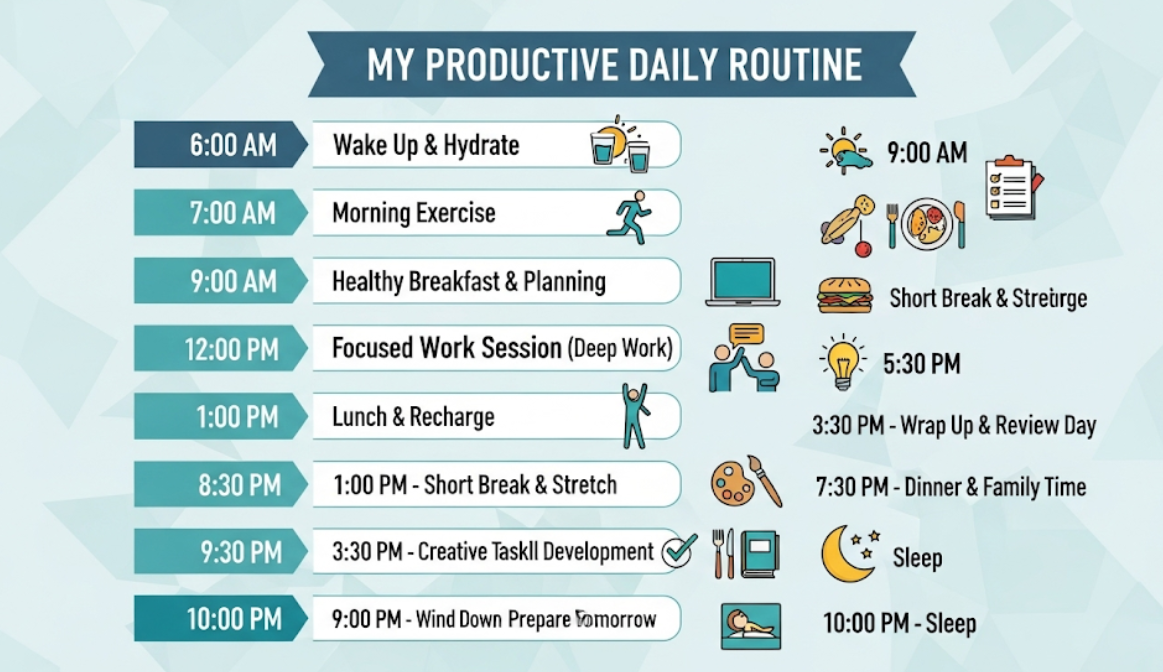
Putting It All Together: The Tools and Systems That Make It Work
Essential Productivity Tools
The utility of your routine heavily depends on having the right tools. Systems I use every day:
Task Management:
- Digital calendar with time-blocked schedules
- Simple task list with priority levels
- Monthly and weekly planning sheets
Focus Enhancement:
- Noise-canceling headphones for deep work
- Website blocking during focus periods
- Physical timer for Pomodoro technique
Health Tracking:
- Sleep quality monitoring device
- Hydration app
- Simple activity tracker
Environment Control:
- Adequate lighting (natural daylight)
- Comfortable, ergonomic workspace
- Temperature control for optimal comfort
Creating Your Personal System
Tools are secondary to having your own system that works with these core components. When choosing productivity tools, consider:
- Simplicity: Pick a tool, but stick with it
- Integration: Tools should work together, not complicate everything
- Reliability: Use systems that work even during technological failures
- Flexibility: Tools should respond to changes in requirements and use cases
Common Challenges and Solutions
Challenge 1: Morning Resistance
Problem: Difficulty waking up early and sticking to morning routine
Solutions:
- Gradually change your wake-up time (15 minutes earlier every week)
- Prepare the night before to minimize morning decisions
- Get light exposure immediately upon waking
- Use an accountability partner or tracking system
Challenge 2: Afternoon Energy Crashes
Problem: Sudden productivity drop in the afternoon hours
Solutions:
- Adjust nutrition timing and composition
- Schedule strategic breaks
- Match tasks to energy levels
- Use therapeutic light or natural daylight exposure
Challenge 3: Evening Screen Time
Problem: Struggle to power down tech before bed
Solutions:
- Step down gradually instead of stopping completely
- Replace screen time with other enjoyable activities
- Use apps that reduce blue light over time
- Keep bedroom space free of devices
Challenge 4: Weekend Routine Collapse
Problem: Letting your weekend routine slip away entirely
Solutions:
- Create structure that constrains you without being inflexible
- Use weekends to set up weekday success
- Review and adjust your weekly routine on weekends
- Balance rest with structure
Measuring Success and Making Adjustments
Key Performance Indicators
I track several key metrics to ensure the routine remains effective:
Daily Metrics:
- Energy level (on a 1–10 scale) at different times
- Number of important tasks completed
- Sleep quality and duration
- Overall mood and satisfaction
Weekly Metrics:
- Progress in different areas of life
- Routine adherence percentage
- Physical activity consistency
- Social and family time quality
Monthly Metrics:
- Major project progress
- Health and fitness improvements
- Relationship quality maintenance
- Personal development progress
The Continuous Improvement Mindset
A productive routine is not a rigid system — it is a concept that takes on different shapes and forms depending on your current needs. The key is a series of small, sustainable changes, not giant sweeping gestures.
Regular Adjustment Strategies:
- Weekly 15-minute routine review sessions
- One monthly deep dive into what is working
- Quarterly major adjustment periods
- Annual complete routine restructuring
Perfection is not the goal, but consistency and continuous improvement are what leads to long-term success.
How to Build Your Own Working Routine
Remember that the routine I shared works for my lifestyle, work demands, and personal preferences. Your perfect routine will probably differ, and that is the way it should be. You just have to take the understanding of what makes a schedule work and apply it to your own situation.
Start by identifying:
- When do you have the most natural energy?
- What are your non-negotiable commitments?
- Which tasks need the most effort? (assign them when your energy is highest)
- What are your priority tasks? (these should be completed first during the day)
Next, create a system around these principles that is adaptable to what life throws at you.
Building a habit takes time, so be patient with yourself. Make small changes, be kind with the process, and focus on consistency, not perfection. The compounded effects of these small daily improvements will express themselves as incredible results over the months and years.
Living a more productive life is not about squeezing more into every day; it’s about intentionally creating systems to support the behaviors that allow you to consistently prioritize what matters most while staying in balance across your health, relationships, and everything else you care about. A routine is the vehicle for your intentions.
The benefits of a well-designed daily routine go far beyond productivity metrics. It provides a feeling of being in control, shields you from decision fatigue, and gives you the framework for doing meaningful work consistently. More importantly, it allows you to automate the basics and focus on what really matters.
Start tweaking as needed and get started right now on building the foundation for your day. The more you invest in creating these healthy systems and structures that support your growth, the more your future self will thank you for it.
